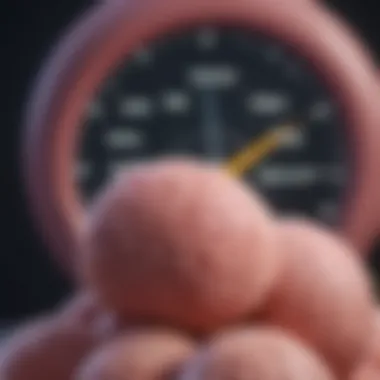Understanding Prognosis and Survival Rates in Testicular Cancer


Intro
Testicular cancer is a significant health issue that primarily affects younger men. Understanding the prognosis and survival rates associated with this type of cancer is crucial for patients, healthcare professionals, and their families. This section deals with the importance of comprehending various factors that influence prognosis, treatment options available, and how these elements are interrelated.
The prognosis refers to the likely outcome of the disease, which encompasses survival rates and potential for recovery. Survival rates are statistically derived data showing the percentage of patients who are alive after a specified period, commonly five years, post-diagnosis. Testicular cancer is unique because it usually has a high cure rate when detected early. Thus, awareness of its stages and treatment effectiveness can contribute meaningfully to better outcomes for those affected.
Another vital aspect to consider is the psychological and emotional impact on patients and their families. They often face uncertainty, fear, and concern about the future. Addressing these developmental needs is part of a holistic approach to treatment, ensuring that patients can navigate their journeys effectively.
In the following sections, we will take a closer look at the various dimensions of testicular cancer prognosis and survival, informed by recent research and clinical findings. This will include a discussion on the epidemiology and stages of the disease, as well as treatment strategies and relevant survival statistics.
"Awareness and early detection remain our strongest ally in improving outcomes for testicular cancer patients."
Research Overview
Summary of Key Findings
Recent studies have revealed essential insights into the survival rates of testicular cancer patients. The five-year survival rate for localized testicular cancer can exceed 95%. This is primarily attributed to advances in detection and treatment options, including surgical interventions and chemotherapy.
The resilience of a patient’s prognosis can be influenced by several factors. These include:
- Stage of Cancer: Early stage diagnosis correlates with higher survival rates.
- Tumor Type: Seminomas tend to respond better to treatment than non-seminomatous germ cell tumors.
- Patient's Age and Overall Health: Younger patients often show improved resilience against the disease.
Relevance to Current Scientific Discussions
The significance of understanding prognosis and survival in testicular cancer is further highlighted by ongoing scientific discussions in oncology. Many researchers focus on personalized treatment approaches that consider genetic markers and tumor biology, aiming to tailor interventions that specifically work for individual patients.
Historically, testicular cancer has served as a model for studying other cancers due to its high survival rates and the psychological burden it imposes on younger men. The ongoing dialogue and research contribute to a more profound comprehension of cancer’s complexities, fostering advancements in treatment strategies and enhancing patient care.
Methodology
Research Design and Approach
The research surrounding testicular cancer prognosis predominantly employs observational studies. These studies provide insights by aggregating extensive patient data from various demographics, allowing researchers to draw connections between treatment efficacy and outcome measures.
Data Collection and Analysis Techniques
Data collection methods often include:
- Retrospective Analysis: Reviewing patient records over a specific timeline to gauge outcomes based on previous treatments.
- Surveys and Interviews: Gauging psychosocial impacts on patients and their experiences, which provides a qualitative aspect to the research.
Statistical analysis techniques applied to this data include survival curves, which illustrate the probability of survival over specified time intervals, thus offering informative visual representations of patient trajectories.
The combination of these approaches provides a multifaceted understanding of prognosis in testicular cancer, which will be discussed in more detail in the subsequent sections.
Intro to Testicular Cancer
Testicular cancer, while relatively uncommon, significantly affects a subset of the male population and merits thorough discussion. Understanding this disease is crucial as it can lead to early detection, effective treatment, and improved outcomes. The insights provided here build a solid foundation for grasping the complexities surrounding diagnosis, treatment, and survival rates.
Definition and Overview
Testicular cancer arises from the tissues of the testis, the organ responsible for producing sperm and male hormones. It largely affects younger men, typically those aged between 15 and 35. This demographic shift marks testicular cancer as unique compared to other cancers, which often tend to occur in older populations. The forms of testicular cancer include seminomas and non-seminomas, which behave differently and respond to treatments uniquely.
Recognizing the symptoms such as lumps or swelling, changes in size, and even discomfort in the testicular area is essential for men. Early diagnosis is linked to much higher survival rates and can greatly affect treatment options. Thus, awareness and education surrounding testicular cancer is vital.
Epidemiological Insights
Epidemiological studies reveal important trends in the prevalence and outcomes of testicular cancer. In many regions, the incidence has risen over the past few decades. Factors contributing to this phenomenon might include genetic predispositions, environmental influences, and conditions such as cryptorchidism, which is when one or both testicles do not descend properly.
Reports indicate that testicular cancer generally has a favorable prognosis compared to other tumors. The five-year survival rate can exceed 95% when detected early. This statistic underscores the importance of awareness and vigilance regarding potential symptoms.
Studies illustrate the impact of understanding testicular cancer on enhancing early detection. As such, continued educational efforts are warranted to ultimately improve patient outcomes.
Understanding Survival Rates
Understanding survival rates in testicular cancer offers critical insights into the outcomes and expectations for affected individuals. These rates serve as benchmarks that summarize how many people with the disease are likely to survive over specific time frames. This understanding is pivotal as it not only aids healthcare professionals in tailoring treatment plans but also helps patients and their families navigate their options and expectations during a challenging time.
Survival rates are influenced by a multitude of factors, including cancer stage, treatment methods, and the patient's overall health. Knowing these rates can empower patients to make informed decisions about their treatment and management options. Moreover, understanding survival statistics can also provide a sense of hope and reassurance, striking a balance between medical data and quality of life.
Definition of Survival Rate
A survival rate is a statistical measure that represents the percentage of people who remain alive for a certain period after being diagnosed with a specific disease. In testicular cancer, this rate is typically expressed in terms of a five-year survival rate, indicating the percentage of people who live at least five years post-diagnosis.


It is important to note that these rates are based on data collected from large groups of patients and do not account for individual variations. Factors such as lifestyle, treatment response, and underlying health conditions can significantly influence a person’s prognosis, making it essential not to rely solely on statistics when considering one's own future.
Five-Year Survival Rates Explained
Five-year survival rates provide a crucial perspective on the treatment outcomes for testicular cancer. For instance, according to recent data, the five-year survival rate for stage I testicular cancer often exceeds 95%. This highlights the effectiveness of early detection and prompt treatment.
In stage II, the survival rate can range around 70% to 90%, depending on various factors such as whether lymph nodes are involved. The prognosis declines further in stage III, with survival rates typically between 50% and 70%. These figures provide essential context for patients and clinicians alike, framing expectations and guiding further discussions about treatment and lifestyle choices.
"Survival rates provide a context but should not dictate the personal journey of those affected by testicular cancer."
While survival statistics are essential for forming a general understanding, they are inherently averages based on large populations. Therefore, they cannot account for every individual’s unique circumstances. It is crucial for patients to engage in open discussions with their healthcare providers to fully understand their particular prognosis based on their specific condition and health profile.
Factors Affecting Prognosis
Understanding prognosis in testicular cancer is essential for patients and healthcare professionals alike. It helps inform treatment decisions and provides insight into likely outcomes. Several factors influence prognosis, including the stage of cancer at diagnosis, the presence of specific tumor markers, and the patient’s age and overall health. Each of these elements plays a role in creating a complete picture of the individual’s situation, which can lead to more targeted and effective management of the condition.
Stage of Cancer at Diagnosis
The stage of cancer at diagnosis is perhaps one of the most significant determinants of prognosis. Testicular cancer is generally classified into three main stages, ranging from localized disease to metastatic conditions.
- Stage I involves cancer that is confined to the testicle.
- Stage II indicates spread to nearby lymph nodes.
- Stage III signifies that cancer has further spread, potentially affecting distant organs.
Early-stage detection usually correlates with better survival rates. Statistics show that patients diagnosed with Stage I testicular cancer have a five-year survival rate exceeding 95%. In contrast, once cancer progresses to Stage III, the survival rate drops significantly. This underscores the importance of early diagnosis and staged treatment.
Tumor Markers and Their Significance
Tumor markers are substances produced by cancer cells or by the body in response to cancer. In testicular cancer, certain biomarkers such as alpha-fetoprotein (AFP), human chorionic gonadotropin (hCG), and lactate dehydrogenase (LDH) are critical in determining prognosis.
- Elevated levels of AFP and hCG often indicate non-seminomatous germ cell tumors, which can lead to a more aggressive treatment approach.
- LDH levels can reflect tumor burden and are used to track treatment response.
Understanding tumor markers helps in guiding therapeutic decisions, as well as in predicting potential outcomes based on initial values. Accurate evaluation of these markers can provide insight into treatment efficacy and subsequent changes in prognosis.
Patient Age and Overall Health
The age and overall health of the patient significantly shape their recovery trajectory and disease management. Younger patients, particularly those in their 20s and early 30s, generally have better outcomes compared to older adults. This might be due to better tolerability of aggressive treatments like chemotherapy and surgery. Overall health, including comorbidities and lifestyle factors, also greatly impacts the recovery process.
- Patients with conditions such as diabetes or heart diseases may face more complications during treatment.
- Lifestyle choices such as smoking and diet can affect overall health and recovery.
Thus, promoting a healthy lifestyle and addressing existing health concerns is critical for better prognosis.
"Understanding these factors can help patients and providers tailor treatment options to improve outcomes."
In summary, recognizing the elements that influence prognosis is vital in navigating the complexities of testicular cancer. By focusing on the stage at diagnosis, the significance of tumor markers, and the overall health of the patient, better engagement in treatment planning and improved survival probabilities can be achieved.
Diagnostic Procedures
Diagnostic procedures play a key role in the management of testicular cancer. They are essential in determining the presence, type, and extent of cancer. The effectiveness of the treatment plan relies heavily on accurate and timely diagnostics. In this section, we will explore the various methods used to assess and confirm testicular cancer, including the initial assessment and imaging techniques, as well as the importance of pathological evaluation.
Initial Assessment and Imaging Techniques
When testicular cancer is suspected, the initial assessment begins with a thorough medical history and physical examination. Physicians will often inquire about any swelling, pain, or changes in the testicles. They may also request a variety of imaging techniques to gain better insight into the condition.
The most common imaging techniques include:
- Ultrasound: This non-invasive procedure uses sound waves to produce images of the testicles. It is often the first line of investigation and helps distinguish between solid tumors and cysts.
- CT Scans: A computed tomography scan provides detailed images of the abdomen and pelvis. It helps determine whether the cancer has spread beyond the testicles.
- MRI: Magnetic resonance imaging is sometimes used if there are concerns about specific areas or if CT results are inconclusive.
These imaging techniques are vital because they help tailor the treatment approach based on the tumor's characteristics. Understanding the location and spread of the cancer can significantly affect the prognosis and survival strategy.
Pathological Evaluation
Following imaging, pathological evaluation is necessary for a confirmative diagnosis. Tissue samples may be obtained via biopsy or surgical removal. This phase involves examining the cells under a microscope to identify the type of cancer cells and the grade of the tumor.
Key aspects of pathological evaluation include:
- Histological Analysis: This determines the cellular structure of tumors, which can indicate how aggressive the cancer may be.
- Tumor Markers: Certain proteins produced by cancer cells can be measured in the blood. Common tumor markers for testicular cancer include alpha-fetoprotein (AFP) and human chorionic gonadotropin (HCG). Their presence can provide insights into cancer types and the effectiveness of treatment.
Pathological evaluation is pivotal in guiding treatment decisions. Accurate diagnosis can lead to more effective management strategies, improving patient outcomes.
Treatment Options for Testicular Cancer
Treatment options play a vital role in the management of testicular cancer. Choosing an appropriate treatment plan can influence not just survival rates but also the quality of life for patients. Each patient's situation is unique and requires careful consideration of the stage of cancer, overall health, and personal preferences. The three main treatment modalities available include surgical intervention, chemotherapy regimens, and radiation therapy. Each offers specific advantages and has its own considerations that could impact the outcome.


Surgical Intervention
Surgical intervention is often the first step in treating testicular cancer. Known as orchiectomy, this procedure involves the removal of one or both testicles and is critical for diagnosing the tumor type and stage accurately. Orchiectomy offers immediate benefits, such as the prevention of cancer spread to nearby tissues.
The key factors regarding surgical intervention include:
- Diagnosis and staging: Understanding the cancer extent helps in planning further treatment.
- Minimally invasive options: In some cases, laparoscopic techniques may be used to reduce recovery time.
- Psychological impacts: For many, losing a testicle can have profound effects on self-image, making counseling and support crucial.
Although orchiectomy is effective, surgery is not always sufficient on its own. Additional treatments may be necessary depending on the diagnosis.
Chemotherapy Regimens
Chemotherapy plays an important role, especially for patients with advanced stages of testicular cancer. This systemic treatment employs drugs that target rapidly dividing cells, which includes cancer cells. The choice of chemotherapy regiment may depend upon tumor type and stage. Commonly used drugs for testicular cancer include cisplatin, etoposide, and bleomycin.
- Combination therapy: Often, a combination of drugs is preferred to enhance effectiveness.
- Adverse effects: While chemotherapy can significantly improve survival rates, it can also result in side effects like nausea, fatigue, or increased risk of infections.
Monitoring and adjusting the chemotherapy regimen is also critical. Regular check-ups during treatment help manage side effects and response to therapy.
Radiation Therapy
Radiation therapy is another treatment modality that can be beneficial for certain patients, particularly those with stage I or II testicular cancer. The treatment uses high-energy rays to target and destroy cancer cells. Its effectiveness often lies in its ability to treat residual cancer cells after surgery.
- When is it used?: Radiation is typically utilized after surgery or when there is concern for cancer spread.
- Treatment planning: Careful assessment is required to minimize exposure to surrounding healthy tissues.
- Long-term effects: Survivors must be aware of the possible long-term side effects, such as changes in fertility or secondary cancers.
Survival Statistics by Stage
Survival statistics by stage are critical for understanding how testicular cancer affects patients at various points in its progression. These statistics offer valuable insights into the expected outcomes for individuals diagnosed with the disease. They help guide treatment plans and provide a framework for understanding the effectiveness of medical interventions based on the cancer’s advancement.
For patients and healthcare providers alike, knowing the survival rates associated with each stage can assist in decision-making. This knowledge informs discussions about the best possible treatment approaches, expected side effects, and overall prognosis. The benefits also extend to enhancing patient education, as understanding their specific stage can empower patients with realistic expectations about their journey.
Stage Testicular Cancer
Stage I testicular cancer is characterized by the presence of cancer in the testicle alone. It has not yet spread to lymph nodes or other areas of the body. According to recent statistics, the five-year survival rate for Stage I testicular cancer is exceptionally high, often reported at around 95% or more.
Patients in this stage typically have the most favorable prognosis. Treatment often involves surgical removal of the affected testicle, a procedure known as orchiectomy. In certain cases, surveillance or additional treatments such as chemotherapy may be recommended based on tumor characteristics. This proactive approach seeks to minimize the chance of recurrence and ensure the best possible outcomes for patients.
Stage Testicular Cancer
In Stage II, testicular cancer has spread to nearby lymph nodes, but it remains localized. The survival rates for this stage still reflect promising outcomes, with five-year survival rates commonly reported between 85% and 95%.
Management of Stage II testicular cancer typically starts with surgical intervention similar to Stage I. Patients may also undergo adjuvant chemotherapy depending on how aggressive the tumor is. Regular follow-up is crucial to monitor for any signs of progression or metastasis. Awareness of these factors allows patients and healthcare providers to work together to reinforce treatment plans that align with the patient’s health goals.
Stage Testicular Cancer
Stage III testicular cancer indicates a more advanced condition, where the cancer has spread to distant lymph nodes or other organs within the body. The prognosis in this stage decreases in comparison to earlier stages, but notable advances in medical treatment have still led to survival rates around 70% to 80% for patients.
Treatment protocols typically include a combination of orchiectomy, chemotherapy, and possibly radiation therapy, depending on individual cases and specific characteristics of the cancer. Despite the challenges presented by Stage III disease, ongoing advancements in precision medicine and targeted therapies offer hope.
"Survival statistics provide a guiding light for patients navigating their cancer journey, illuminating the path forward and informing treatment options."
Survival statistics are essential tools in evaluating the effectiveness of treatments and understanding the disease. They impact both medical practice and patient experience, ensuring informed decisions can be made at every stage of testicular cancer.
Long-Term Effects and Follow-Up Care
The journey after a testicular cancer diagnosis does not end with successful treatment. Understanding the long-term effects and appropriate follow-up care is crucial for maintaining health and well-being for survivors. After treatment, patients may face several lasting impacts, both physical and emotional. Recognizing these factors allows for better management and improved quality of life.
Monitoring for Recurrence
Monitoring for recurrence is a vital aspect of post-treatment care. Testicular cancer can return, and the likelihood varies based on the initial cancer stage and treatment method used. Regular follow-ups help in early detection, which is essential as early intervention is likely to improve outcomes.
Typically, follow-up care consists of:
- Regular Physical Exams: These visits allow healthcare providers to check for any physical signs of recurrence. Patients should expect these check-ups at least every three to six months for the first two years.
- Blood Tests for Tumor Markers: Blood tests measuring specific markers, such as alpha-fetoprotein (AFP) and human chorionic gonadotropin (hCG), are essential. Elevated levels may indicate a return of cancer.
- Imaging Tests: Depending on the initial stage and treatment received, imaging such as CT scans may be recommended at certain intervals.
Patients should maintain an open line of communication with their healthcare team. Discussing any new symptoms, however minor, is necessary for catching recurrence early.
Managing Late Effects of Treatment
The treatments for testicular cancer, while often effective in eradicating the disease, can lead to late effects that require attention. These effects can manifest months or years after treatment has concluded. Education about potential side effects is paramount.
Some common late effects include:


- Fertility Issues: Treatments can impact testosterone levels and fertility. Consults with a reproductive specialist may be necessary for those wishing to conceive in the future.
- Cardiovascular Health: Certain chemotherapy drugs may increase the risk of heart issues later on. Patients should engage in healthy lifestyle changes and regular check-ups to monitor heart health.
- Psychosocial Effects: Many survivors may experience anxiety or depression. Professional counseling or support groups can provide emotional support and strategies to cope with these challenges.
Regular follow-ups and monitoring of late effects can significantly enhance a survivor’s quality of life. Patients should engage with their healthcare providers to develop a comprehensive follow-up plan tailored to their specific needs.
"Understanding the late effects of treatment can empower survivors to take proactive steps towards their health and well-being."
Psychosocial Impact of Testicular Cancer
The psychosocial impact of testicular cancer is significant in understanding the overall experience of patients. This aspect extends beyond mere medical treatment; it encompasses emotional, mental, and social challenges that arise during and after a cancer diagnosis. Patients often navigate a complex web of feelings, including anxiety, uncertainty, and depression. Recognizing these challenges is essential for healthcare providers, patients, and their support systems.
Understanding the psychosocial facets can make a notable difference in patient care. It promotes a more holistic approach to treatment, enhancing communication and empathy between healthcare professionals and patients. Given the high survival rates of testicular cancer, focusing on psychosocial support becomes crucial in promoting long-term well-being and quality of life.
Mental Health Considerations
Mental health is a vital component of survivorship in testicular cancer. After diagnosis and treatment, many patients face emotional burdens that are often overlooked. Feelings of inadequacy and fear of recurrence may arise, impacting daily life and relationships.
Common mental health issues include:
- Anxiety: Patients may constantly worry about their health.
- Depression: The emotional weight of the diagnosis can lead to persistent sadness.
- Body Image Issues: Changes due to surgery or treatment can affect self-esteem.
These factors can hinder recovery or compliance with follow-up care. Educational resources around mental health can help patients understand their feelings and cope with them effectively. Therapies such as cognitive behavioral therapy or support groups can provide valuable outlets to express their feelings and connect with others in similar situations.
Support Systems for Survivors
Survivors of testicular cancer often benefit greatly from structured support systems. Family and friends play an essential role, providing emotional backing and practical assistance. Survivorship programs and patient support groups are equally important. These programs not only allow survivors to share their experiences but also facilitate connections that can reduce feelings of isolation.
Key elements of effective support systems include:
- Peer Support Groups: Hearing from others who have faced similar challenges can be validating.
- Counseling Services: Professional mental health support offers ways to process emotions.
- Educational Workshops: Sessions that inform patients about survivorship issues can empower them.
"The role of support systems can significantly enhance resilience among survivors, leading to improved mental health and overall quality of life."
Staying Informed and Empowered
Staying informed and empowered is crucial for individuals facing a diagnosis of testicular cancer. Knowledge enables patients to make informed decisions about their health and treatment options. This empowerment leads to active participation in their care process, which can significantly enhance their quality of life. In a landscape where medical information is dynamic and constantly evolving, understanding one's condition can also alleviate feelings of anxiety and isolation.
Education about testicular cancer involves understanding the intricacies of the disease, its stages, potential treatments, and the side effects associated with them. One of the essential benefits of patient education is better communication with healthcare providers. An well-informed patient can articulate symptoms, concerns, and preferences more effectively. This collaboration between patient and provider is vital for optimizing treatment plans.
In addition, having access to accurate and comprehensive resources can foster resilience and hope among patients. When individuals understand their prognosis and potential survival rates, they can set realistic expectations and goals for their health journey. Awareness of available support mechanisms and community resources is equally important. All of these elements help build a foundation for coping techniques that individuals can utilize during and after treatment.
"The greatest weapon against stress is our ability to choose one thought over another." - William James
The Role of Patient Education
Patient education plays an integral role in the management of testicular cancer. It serves as an avenue for collecting vital knowledge that informs choices. Through education, patients acquire insights into the nuances of their diagnosis and treatment options. This knowledge extends beyond medical jargon; it includes understanding how cancer affects one’s lifestyle, emotional well-being, and financial considerations.
Educational resources can come in various forms, including:
- Informational websites: The internet hosts numerous resources. Websites like Wikipedia and Britannica provide foundational information.
- Support groups: Engaging with others who are navigating similar experiences often enhances understanding.
- Healthcare provider sessions: Regular consultations offer insights tailored to individuals.
By participating in patient education initiatives, individuals can demystify their condition. This clarity can boost confidence and enable more meaningful discussions about treatment plans with their physicians.
Resources for Ongoing Support
Access to ongoing support is pivotal for those affected by testicular cancer. Emotional, psychological, and logistical challenges arise during and after treatment, making a robust support network essential. Various resources help patients find their footing in coping with the aftermath of their diagnosis.
Some notable resources include:
- Crisis hotlines: Immediate assistance is available for those dealing with emotional distress. These can provide quick help in crisis situations.
- Online forums: Platforms like Reddit facilitate discussions among survivors and those currently battling the disease, offering insights and shared experiences.
- Psychological counseling: Trained professionals can guide patients through what's often a confusing emotional landscape post-diagnosis.
By taking advantage of these resources, patients and survivors can continue to educate themselves and build a support network that fosters empowerment. In a landscape of uncertainty, finding community and reliable information can be a beacon of hope.
Culmination
The conclusion of this article on testicular cancer is critical in synthesizing the comprehensive insights provided throughout the various sections. It encapsulates the essence of understanding both prognosis and survival rates as they relate to this specific type of cancer. The prognosis for testicular cancer is generally favorable, particularly when the condition is diagnosed at an early stage. Recognizing this can offer significant psychological relief for patients and their families, which is an essential aspect of coping.
In reviewing the various factors influencing outcomes—from the biological behavior of the tumors, patient demographics, overall health to available treatment options—readers can appreciate the complexity of prognosis. The importance of early detection and effective treatment cannot be overstated, as these elements significantly impact the survival rates.
"Understanding the prognosis not only informs treatment decisions but also empowers patients to take an active role in their healthcare journey.”
Moreover, the psychosocial aspects discussed in earlier sections accentuate the importance of considering mental health and lifestyle adjustments post-diagnosis. Empowered patients who are informed about their options and the potential long-term effects are better equipped to face their journey ahead. Consequently, support networks, reliable educational resources, and mental health considerations should be woven into the fabric of patient care.
Summarizing the Prognosis
Prognosis in the context of testicular cancer indicates that most individuals can expect favorable outcomes, particularly those diagnosed in the earlier stages. The five-year survival rates for stage I testicular cancer are notably high, often exceeding 95%. For patients diagnosed at stage II, the survival rates remain encouraging but may slightly decrease, contingent upon other factors like the specific tumor markers. Consequently, it becomes vital for patients and healthcare providers to maintain open communication regarding expectations and care plans.
Future Directions in Research
Looking forward, there are several promising directions in research focused on testicular cancer. Advances in personalized medicine provide a pathway for tailoring therapies based on individual tumor markers and genetic profiles. Further investigations into the late effects of cancer treatment also warrant attention, as understanding and managing these can significantly enhance the quality of life for survivors. Moreover, ongoing research into new chemotherapy protocols and targeted therapies promises to improve outcomes and minimize side effects. Encouragingly, the increase in awareness and funds directed towards testicular cancer research provides hope for continual advancements in treatment and patient care.



